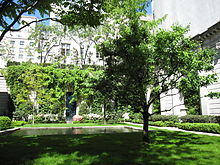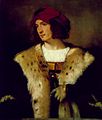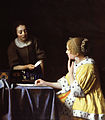Frick Collection

The Frick Collection is an art museum in New York City , USA, opened in 1935 and shows predominantly significant European paintings.
The building is located at the south end of Museum Mile on the Upper East Side of New York City's Manhattan on Fifth Avenue and 70th Street.
history
The model was the collection of Richard Wallace , who converted his home in London together with his art collection into a museum and made it accessible to the public as the Wallace Collection . Henry Clay Frick (1849–1919) saw this collection in London and was enthusiastic about the intimate presentation of the works of art.
Frick had amassed considerable fortune in the Pittsburgh steel industry and merged his company with that of Andrew Carnegie . In 1905 he moved to New York City to spend his old age here. He rented William H. Vanderbilt's mansion , designed by Richard Morris Hunt , on Fifth Avenue and 52nd Street, where the family lived for 9 years. In 1906, Frick began making plans to build his own house in New York and bought a piece of land on 70th Street and 5th Avenue. At that time, however, the Lenox Library was still there and Frick had to wait until the New York Public Library opened in 1911 to house the Lenox Library. Although Frick had offered to relocate the Lenox Library to another location at his own expense, no agreement could be reached with the city. When he received the title deed for the property in 1912, the building was demolished. After planning for the house was finished in 1912, construction could begin in 1913.
He commissioned the architects Carrère and Hastings to build a villa on Central Park . A representative residence for Henry Clay Frick, his wife Adelaide and his daughter Helen, who moved into the house in November 1914, was built on the corner of Fifth Avenue and 70th Street in 1913/1914 for $ 5,000,000. Frick's son Childs had married Frances Shoemaker Dixon in the fall of 1913 and never lived in this house.
Charles Allom from the British company White, Allom & Co. was chosen for the interior design of the rooms on the ground floor as well as the breakfast room and Frick's personal living room. Allom designed a stable table for the library. The cabinets were held halfway high to provide enough space for his pictures on the walls. The remaining rooms on the upper floors were decorated by Elsie de Wolfe . There is an interesting correspondence between Frick and de Wolfe in the Frick archives.
After Frick's death in 1919, the house with the art collection of 131 pictures was transferred to a foundation, but was initially continued to be inhabited by his widow. After her death in 1931, the building was converted for use as a museum, and two exhibition rooms, a concert and lecture hall and an atrium were added. In 1935 the Frick Collection opened its doors to the public. In addition to the house and the collection, Henry Clay Frick bequeathed $ 15 million to the foundation for the maintenance of the collection and other acquisitions. The foundation bought 75 more paintings. In 1977 the Frick Collection received two more exhibition rooms for temporary exhibitions.
In 2011 the portico of the exhibition building was glazed and furnished for the Meissen porcelain collection by Henry H. Arnhold and for sculptures.
The Frick Collection was a model for many patrons in the United States, for example the Kimbell Art Museum in Fort Worth, Texas . Andrew Mellon donated his art collection and financed the construction of the National Gallery in Washington, DC
collection
The collection shows more than 1,100 works of art from the Renaissance to the end of the 19th century in 16 gallery rooms .
In 1915, two years after JP Morgan's death, the opportunity arose for Frick to acquire some items from his famous collection, such as: B. paintings, bronze figures, Chinese porcelain and enamels from Limoges . Through the art dealer Joseph Duveen, Frick bought furniture, paintings and objets d'art, including a series of Fragonard panels that were on display at the Metropolitan Museum of Art. The first floor with the living room has been specially renovated to accommodate the panels.
Renaissance Italian painting is represented by artists such as Giovanni Bellini , Gentile Bellini , Agnolo Bronzino , Cimabue , Duccio di Buoninsegna , Gentile da Fabriano , Fra Filippo Lippi , Piero della Francesca , Tizian and Paolo Veronese . There are also later artists such as Giovanni Battista Tiepolo and Francesco Guardi .
English painting of the 18th century is represented with seven works by Thomas Gainsborough . Other British painters in the Frick Collection include John Constable , Francis Cotes , William Hogarth , John Hoppner , Thomas Lawrence , Henry Raeburn , Joshua Reynolds , George Romney and Joseph Mallord William Turner .
The outstanding works of art in Dutch painting of the 17th century include Jan Vermeer the paintings Woman with Maid , The Interrupted Music Lesson and The Soldier and the Laughing Girl , important works by Rembrandt van Rijn , and paintings by Gerard ter Borch , Jan van de Capelle , Aelbert Cuyp , Frans Hals , Jan van der Heyden , Meindest Hobbema , Gabriel Metsu , Jacob van Ruisdael , Salomon van Ruysdael , Isaac van Ostade and Philips Wouwerman . The Frick Collection also shows the Flemish artists Pieter Brueghel the Elder , Gerard David , Hans Memling , Peter Paul Rubens , Jan van Eyck and Anthonis van Dyck , eight of whom are in the Frick Collection.
Francisco de Goya , El Greco and Diego Velázquez are represented as Spanish painters , while German art with a work by Konrad Witz and two paintings by Hans Holbein the Elder are represented. J. is only marginally present.
One focus of the museum is French painting, with separate rooms dedicated to the painters François Boucher and Jean-Honoré Fragonard . The collection also includes works by Jean-Baptiste Pater , Jean-Marc Nattier , Jean-Antoine Watteau , Claude Lorrain , Jean Baptiste Greuze , Chardin and Jacques-Louis David . 19th century artists on display include Camille Corot , Charles-François Daubigny , Jean-Auguste-Dominique Ingres , Edgar Degas , Jules Dupré , Jacob Maris , Anton Mauve , Édouard Manet , Jean-François Millet , Claude Monet , Pierre-Auguste Renoir , Théodore Rousseau and Constant Troyon .
The few American artists in the exhibition include Gilbert Stuart , of whom the museum has a portrait of George Washington in its collection, as well as an extensive collection of graphics and paintings by James McNeill Whistler . The collection also includes sculptures, clocks from the 16th to 19th centuries, silver work, valuable carpets, Chinese porcelain , enamel work from Limoges and French furniture from the 18th century.
particularities
In addition to changing exhibitions and lectures, concerts are held in the museum. An extensive art library ( Frick Art Reference Library ) is attached to the museum and has also been open to the public since 1935.
One of the special features is that the 131 pictures in Henry Clay Frick's original collection do not leave the building, according to the patron's will. Another special feature is the rule that children up to the age of ten are not admitted.
Exhibited works
(Selection)
literature
- Charles Ryskamp: Art in the Frick Collection: Paintings, Sculpture, Decorative Arts. Harry N. Abrams, 1996, ISBN 0-8109-1972-9 .
- Bernice Davidson, Nadia Tscherny, Charles Ryskamp: Paintings from the Frick Collection. Harry N. Abrams, 1991, ISBN 0-8109-3710-7 .
- Frick Collection (Ed.): Handbook of Paintings. Frick Collection, 1971. ISBN 0-912114-08-8 . 144 pp.
- Pictures in the collection of Henry Clay Frick: at one East Seventieth Street, New York Privately printed, Published 1910
- James Howard Bridge: Portraits and personalities: imaginary conversations in the Frick galleries . Publisher Aldine book companyNew York, 1929
See also
Web links
Individual evidence
- ↑ https://www.frick.org/about
- ↑ Frick in Pittsburg - Timeline
- ^ The Lenox Library: The Library as Museum
- ^ One East 70th Street Papers. The Frick Collection / Frick Art Reference Library Archives.
- ↑ https://www.frick.org/about/history
- ↑ Frick New York Residence Construction Album, 1913 ( Memento of the original from April 27, 2017 in the Internet Archive ) Info: The archive link was inserted automatically and has not yet been checked. Please check the original and archive link according to the instructions and then remove this notice. Wurts Brothers' photographs
- ↑ Virtual through the library
- ^ Elsie de Wolfe-The American pioneer who vanquished Victorian gloom . Text by Edgar Munhall Posted December 31, 1999 in “Architectural Design”
- ^ New Portico Gallery (PDF), Frick Collection, accessed December 30, 2015
- ↑ https://www.frick.org/about/gardens/portico
- ^ One East 70th Street Papers. The Frick Collection / Frick Art Reference Library Archives.
- ↑ Website of the Frick Collection ( Memento of the original from May 14, 2008 in the Internet Archive ) Info: The archive link was inserted automatically and has not yet been checked. Please check the original and archive link according to the instructions and then remove this notice. , accessed May 1, 2010
- ↑ https://www.frick.org/research/library
- ↑ https://www.frick.org/research/library/history
Coordinates: 40 ° 46 ′ 16 ″ N , 73 ° 58 ′ 3 ″ W.











